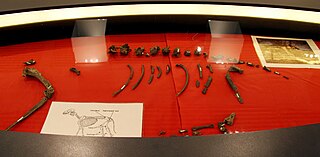
A lynx is any of the four extant species within the medium-sized wild cat genus Lynx. The name originated in Middle English via Latin from the Greek word lynx, derived from the Indo-European root *leuk-, in reference to the luminescence of its reflective eyes.
Panthera is a genus within the family Felidae, and one of two extant genera in the subfamily Pantherinae. It contains the largest living members of the cat family. There are five living species: the jaguar, leopard, lion, snow leopard and tiger, as well as a number of extinct species.

Acinonyx is a genus within the Felidae family. The only living species of the genus, the cheetah, lives in open grasslands of Africa and Asia.

Dinofelis is an extinct genus of machairodontine, usually classified in the tribe Metailurini. It was widespread in Europe, Asia, Africa and North America from 5 million to about 1.2 million years ago. Fossils very similar to Dinofelis from Lothagam range back to around 8 million years ago, in the Late Miocene.

The cave bear is a prehistoric species of bear that lived in Europe and Asia during the Pleistocene and became extinct about 24,000 years ago during the Last Glacial Maximum.

The Iberian lynx is one of the four extant species within Lynx, a genus of medium-sized wild cats. The Iberian lynx is endemic to the Iberian Peninsula in southwestern Europe. It is listed as vulnerable on the IUCN Red List. In the 20th century, the Iberian lynx population had declined because of overhunting, poaching, fragmentation of suitable habitats, and the population decline of its main prey species, the European rabbit, caused by myxomatosis and rabbit haemorrhagic disease. Fossils suggest the species has been present in Iberia since the end of the Early Pleistocene, around one million years ago.
Metailurini is an extinct taxonomic tribe of large saber-toothed cats that lived in Africa, Asia, Europe, and North America from the Miocene to the Pleistocene.

Panthera fossilis, is an extinct species of cat belonging to the genus Panthera, known from remains found in Eurasia spanning the Middle Pleistocene and possibly into the Early Pleistocene.

Hippopotamus antiquus is an extinct species of the genus Hippopotamus that ranged across Europe during the Early and Middle Pleistocene. It was considerably larger than the living hippopotamus.

Acinonyx pardinensis, sometimes called the Giant cheetah, is an extinct felid species belonging to the genus Acinonyx, closely related to the cheetah, native to Eurasia during the Pliocene and Pleistocene epochs. It was substantially larger than the living cheetah.

Xenocyon is an extinct group of canids, either considered a distinct genus or a subgenus of Canis. The group includes Canis (Xenocyon) africanus, Canis (Xenocyon) antonii and Canis (Xenocyon) falconeri that gave rise to Canis (Xenocyon) lycanoides. The hypercarnivorous Xenocyon is thought to be closely related and possibly ancestral to modern dhole and the African wild dog, as well as the insular Sardinian dhole.

Leptobos is an extinct genus of large bovine, known from the Late Pliocene and Early Pleistocene of Eurasia, extending from the Iberian Peninsula to northern China. Species of Leptobos weighed on average 320 kilograms (710 lb). The dietary preference across the genus includes species that were browsers, grazers and mixed feeders. The first appearance of Leptobos in Europe around 3.6-3.5 million years ago is considered to define the beginning of the Villafranchian European faunal stage. Leptobos is considered to be closely related to the insular genus Epileptobos from the Pleistocene of Java, and is considered to be ancestral to Bison. Leptobos became extinct after being replaced by their descendant Bison during the Early Pleistocene, after a period of temporal overlap. "Leptobos" syrticus from Libya likely belongs in a different genus.

Ursus etruscus is an extinct species of bear, endemic to Europe, Asia and North Africa during the Early Pleistocene, living from approximately 2.2 million to around 1.4-1.2 million years ago.

Lycaon sekowei is an extinct canid species from southern Africa that lived during the early Pleistocene epoch, dating from 2 to 1 million years ago.

Fallow deer is the common name for species of deer in the genus Dama of subfamily Cervinae.

Panthera pardus spelaea, also known as the European Ice Age leopard or the cave leopard, is a fossil leopard subspecies which roamed Europe in the Late Pleistocene and possibly the Holocene.
Sivapanthera is a prehistoric genus of felid described by Kretzoi in 1929. Species of Sivapanthera are closely related to the modern cheetah but differ from modern cheetahs by having relatively longer brain cases, flatter foreheads, narrower nostrils and larger teeth. In many ways, skulls of Sivapanthera show similarity to that of the puma, or even those of Panthera. Scholars differ on the validity of this genus, while some think that it should be treated as a distinct genus, others think that its members should be treated as members of the Acinonyx genus, or even as subspecies of Acinonyx pardinensis.
Styriofelis is an extinct genus of Felidae known from the Miocene of Europe.
The Cave of the Angel refers to several cave-related structures located in the Aras mountain range near the town of Lucena, Córdoba province in Spain. The site contains lithic material of an Acheulean typology and dates to that from the Middle Pleistocene to the Upper Pleistocene. There is geological, paleontological, and archaeological evidence indicating an intense and long-term occupation of this site. The numerous bone and lithic remains found in this site, as well as the matrix surrounding them, reveal exposure to fire. This, along with the finding of a wide and deep combustion structure in the stratigraphic profile, support the hypothesis that at the time of the occupation of the site by humans there was processing and consumption of big mammals.

Bison schoetensacki, commonly as the Pleistocene woodland bison or Pleistocene wood bison, was a species of bison that lived from the Early Pleistocene to at least the early Middle Pleistocene from western Europe to southern Siberia. Its presence in the Late Pleistocene is debated.















